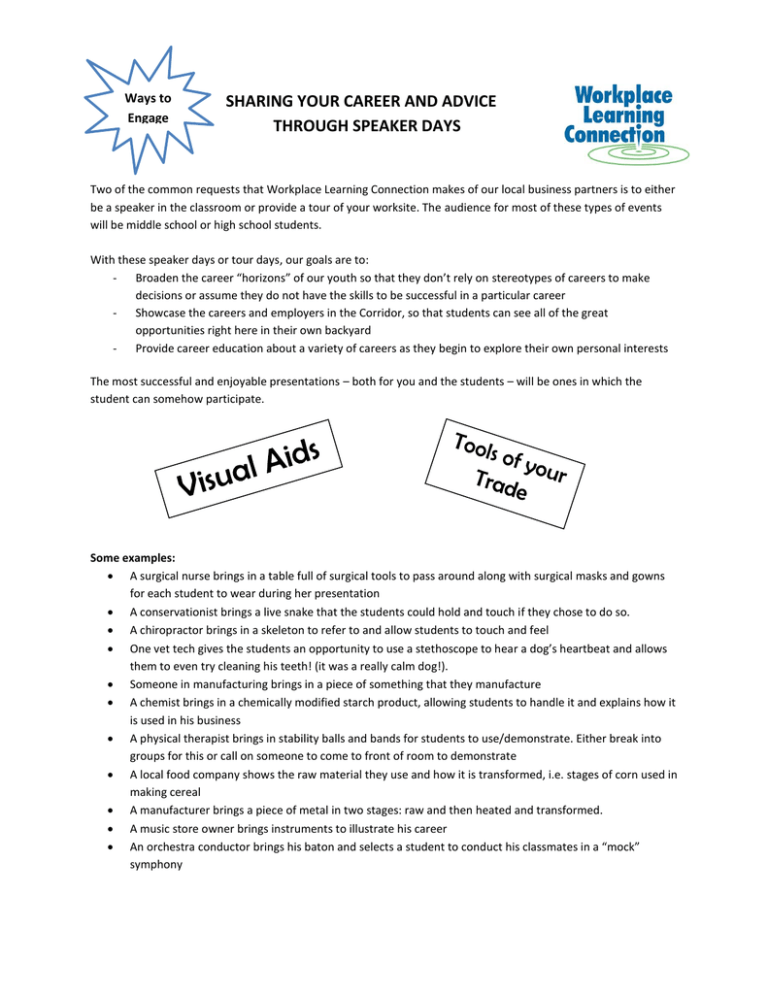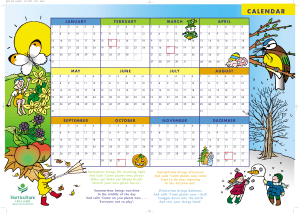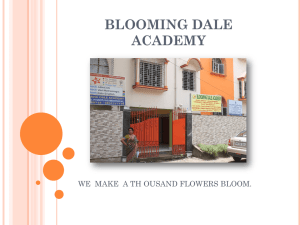SHARING YOUR CAREER AND ADVICE THROUGH SPEAKER DAYS Ways to
advertisement

Ways to Engage SHARING YOUR CAREER AND ADVICE THROUGH SPEAKER DAYS Two of the common requests that Workplace Learning Connection makes of our local business partners is to either be a speaker in the classroom or provide a tour of your worksite. The audience for most of these types of events will be middle school or high school students. With these speaker days or tour days, our goals are to: Broaden the career “horizons” of our youth so that they don’t rely on stereotypes of careers to make decisions or assume they do not have the skills to be successful in a particular career Showcase the careers and employers in the Corridor, so that students can see all of the great opportunities right here in their own backyard Provide career education about a variety of careers as they begin to explore their own personal interests The most successful and enjoyable presentations – both for you and the students – will be ones in which the student can somehow participate. Some examples: A surgical nurse brings in a table full of surgical tools to pass around along with surgical masks and gowns for each student to wear during her presentation A conservationist brings a live snake that the students could hold and touch if they chose to do so. A chiropractor brings in a skeleton to refer to and allow students to touch and feel One vet tech gives the students an opportunity to use a stethoscope to hear a dog’s heartbeat and allows them to even try cleaning his teeth! (it was a really calm dog!). Someone in manufacturing brings in a piece of something that they manufacture A chemist brings in a chemically modified starch product, allowing students to handle it and explains how it is used in his business A physical therapist brings in stability balls and bands for students to use/demonstrate. Either break into groups for this or call on someone to come to front of room to demonstrate A local food company shows the raw material they use and how it is transformed, i.e. stages of corn used in making cereal A manufacturer brings a piece of metal in two stages: raw and then heated and transformed. A music store owner brings instruments to illustrate his career An orchestra conductor brings his baton and selects a student to conduct his classmates in a “mock” symphony Some Examples: Do an experiment or show what chemical processes your company does to make its products. Most teachers are happy to supply you with equipment you might need for this. Create an activity to highlight a skill or skills you use. For example, an engineer divides students into small groups. One person builds a Lego structure based on verbal instructions given to him/her by his teammates. The teammates are using a picture of the completed Lego structure to guide the builder. The engineer brings the students back together and asks how it went and talks about the importance of communication and teamwork skills Have students volunteer to be job applicants. A Human Resources speaker assigned each student a scenario and then asked the class to decide who should be hired. She then followed up by asking how they could then keep that employee through training, compensation, benefits, etc. A family/human services speaker can create an activity that demonstrates counseling skills – break the students into small groups where they can practice some very basics counseling techniques on each other An arts/communications speaker might find an activity that demonstrates communication skills - or an artist or actor might lead the students in a warm-up exercise that they use on a daily basis in their field. A career advisor demonstrates an interest inventory by having students select corners of the room based on selected descriptions given Power Points can be wonderful presentation tools IF used correctly. Don’t rely only on a PP. Here are some suggestions for “spicing” it up. Ask students lots of questions; use incentives (company trinkets, candy) IF you want to Check their prior knowledge before explaining a PP slide - “What do you know about _______?” Keep your PP slides VERY simple – few words and simple words. Avoid jargon and abbreviations. If you are showing something on a slide, consider “can I bring this in live?” Do an activity first to make sure you don’t run out of time for it. If you use a PP, it should be to illustrate a point or show an example. While the “fun activities” and “tool” and “gadgets” will make the presentation interesting and fun, we don’t want to leave you without some ideas of things to talk about! As mentioned above, the goal of these events is to help the students explore careers and introduce them to careers they may have never considered. Toward that end, please see our Speaker Topics/Tips Sheet for topics to cover. These are also likely to be the subject of questions students ask you. Questions? Want to Brainstorm? Call us anytime! - Main Number: 398-1040 Sue Neil: 398-4828 Robin Henessee: 398-2584 Laurie Worden: 398-4826




